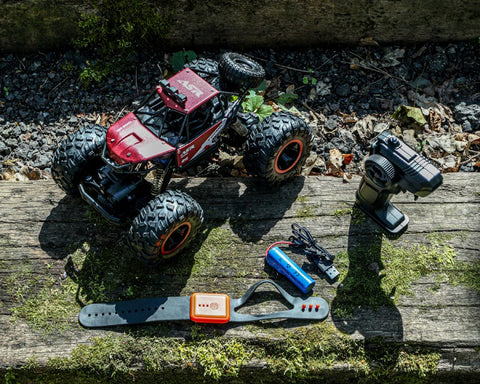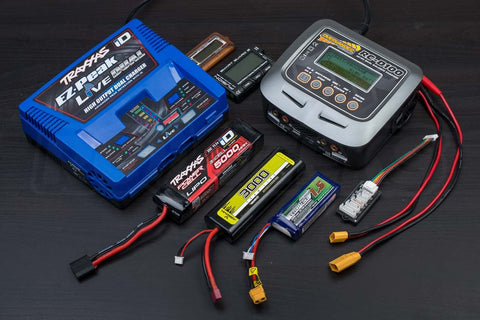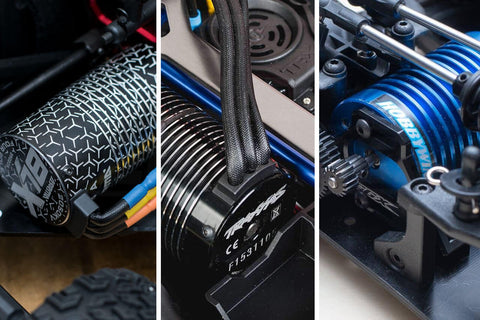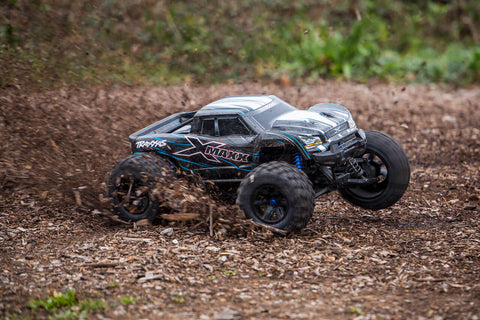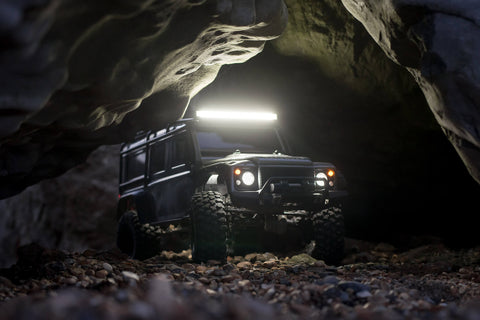If you are new to RC, the multitude of different batteries and battery charging options might seem daunting. In this blog we take a look at power provision in RC Cars, the battery and charger. We explain how to replace, upgrade and shop for your current model, whilst also looking at reducing charge times. Whilst this is aimed at novice remote control car operators, some of the theory is applicable to drone operators.
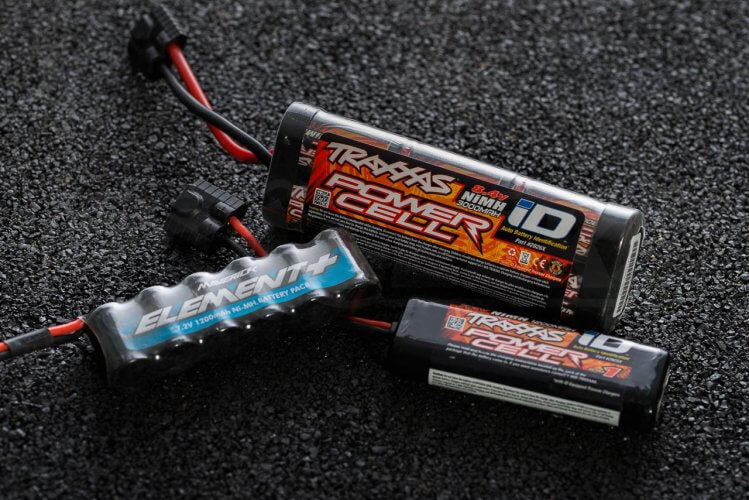
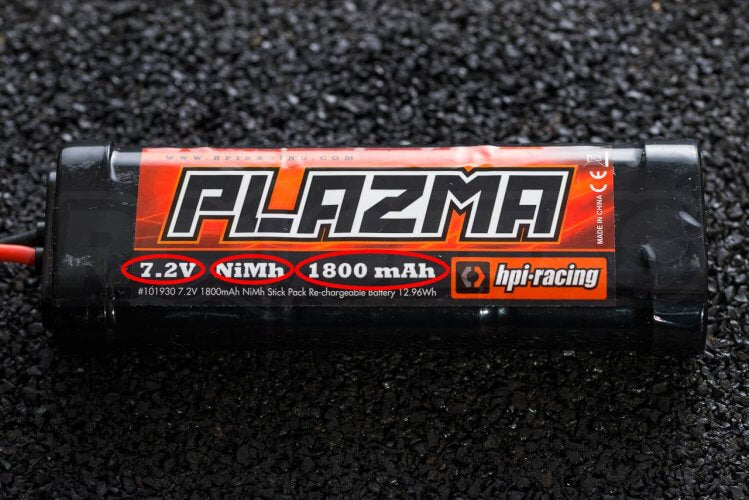 This battery is well labelled and we have circled the core values to make it clear. It is a 7.2volt battery with 1800 mAh capacity, provided by NiMH (Nickel-Metal Hydride) chemistry. The capacity is also stated in Watt Hours (capacity divided by voltage) in this case 12.96Wh. These figures are typical for a bundled battery, 1800 mAh being the low-end of capacity for a stick pack of these dimensions. If you were looking to extend your run-time then swapping out to a 4700mAh battery with the same dimensions and connector would be the easiest step.
This battery is well labelled and we have circled the core values to make it clear. It is a 7.2volt battery with 1800 mAh capacity, provided by NiMH (Nickel-Metal Hydride) chemistry. The capacity is also stated in Watt Hours (capacity divided by voltage) in this case 12.96Wh. These figures are typical for a bundled battery, 1800 mAh being the low-end of capacity for a stick pack of these dimensions. If you were looking to extend your run-time then swapping out to a 4700mAh battery with the same dimensions and connector would be the easiest step.
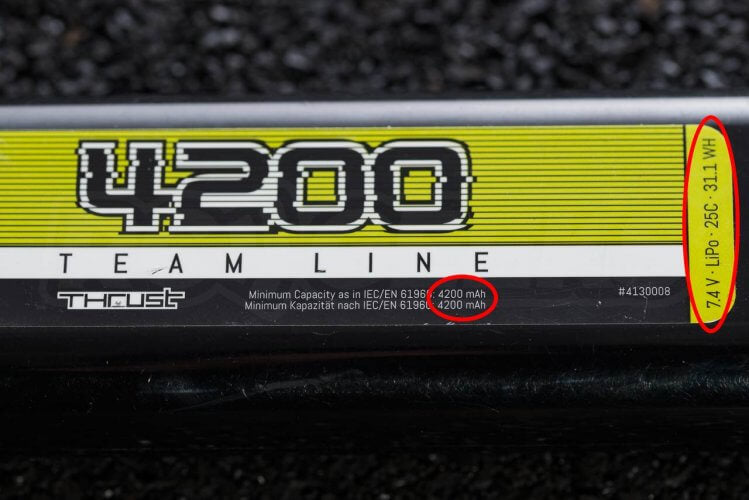 Next we have a LiPo battery from Absima. Its 4200 name reflects its 4200mAh/31.1Wh rating that is less clearly labelled. The finer details are listed at the end of the label 7.4v (2 cell) LiPo technology with a 25C burst rate.
Next we have a LiPo battery from Absima. Its 4200 name reflects its 4200mAh/31.1Wh rating that is less clearly labelled. The finer details are listed at the end of the label 7.4v (2 cell) LiPo technology with a 25C burst rate.
 Lastly this Turnigy Nano-Tech battery with its label offers a lot of information. The 35-70c labelling suggests it can be discharged continuously up to 35C and for short surges up to 70C, offering a little more detail to the 'high discharge Li-Po battery' marking below. On the right we can see that the 3 cell option has been marked, denoting that it features a 3-cell 11.1 volt setup. This high-end battery would be ideal for a high-load RC car, such as our brushless converted Traxxas Defender.
Lastly this Turnigy Nano-Tech battery with its label offers a lot of information. The 35-70c labelling suggests it can be discharged continuously up to 35C and for short surges up to 70C, offering a little more detail to the 'high discharge Li-Po battery' marking below. On the right we can see that the 3 cell option has been marked, denoting that it features a 3-cell 11.1 volt setup. This high-end battery would be ideal for a high-load RC car, such as our brushless converted Traxxas Defender.
Tamiya Connector
Our most common battery connector, found on the majority of NiMH batteries. These (sometimes translucent) white connectors feature a lever to unlock them before pulling them apart. They are keyed to aide installation but it is possible to force the connectors, so care must be taken to observe correct polarisation (connecting the positive to the positive and vice versa) such as identifying wire colours. Note: these are not designed for high current application such as big burst rate LiPo batteries and may overheat if used as such.
These short, chunky connectors are common for high current applications and are found on our HPI Plazma LiPo and Absima lipo batteries. They feature and the short plastic plug bodies, sprung flat tabs that maintain contact pressure against the metal prongs (which can be stiff to connect) and are keyed so will only connect one way round.
XT60 Connector
These high current connectors are popular with drone pilots are simple to use and are keyed to avoid incorrect connection.
These rectangular proprietary high-current connectors are keyed to avoid incorrect connection and feature textured plugs to aid removal. Note that Traxxas now also employ a 'foolproof' iD connector with integral balance connector leads to simplify charging. These are intended for use with iD chargers and can be identified by their flattened octagonal connector.
These tiny two pin connectors are found on batteries for micro drones and the HPI Q32 models. They are designed for use with low current chargers for example USB powered chargers. Again, care should be exercised when connecting these batteries as the small plugs can be forced together the wrong way round.
Often called banana plugs, these are commonly found on charger adapter leads rather than batteries. Available in a range of diameters the larger sizes can support high current, but attention must be paid when connecting them to ensure they are the correct way round.
Often found inside of transmitters, these small, low current, thin-walled plugs are ideal for connecting rechargeable battery packs instead of using AA batteries.
Found on multi-cell batteries, these (commonly white) multi-pin plugs provide a connector to each cell terminal inside of the battery for monitoring the voltage and manipulating each individually. This allows the charger to discharge a particular cell to balance the pack. There will be one wire for each cell plus a negative meaning a 3S battery balance plug will feature four pins. It is important to connect this plug to the charger when balance charging, something commonly overlooked by beginners. Note that some chargers can fill the battery using this low current connection, thus its inclusion in this list.
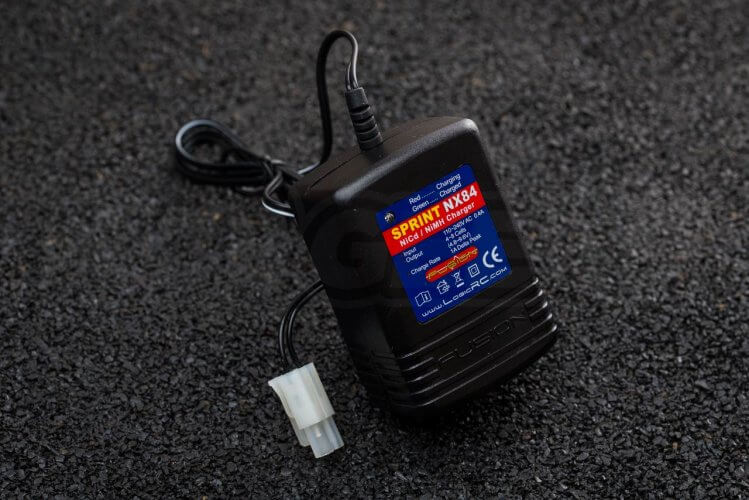
 This popular Overlander charger has a maximum fast charge output of 7A with support for 6cell LiPo and 8cell NiMH batteries. In comparison this could easily charge a 3300mAh battery in less than an hour. Its worth noting that regularly 'fast' charging batteries at high voltages will shorten their life.
This popular Overlander charger has a maximum fast charge output of 7A with support for 6cell LiPo and 8cell NiMH batteries. In comparison this could easily charge a 3300mAh battery in less than an hour. Its worth noting that regularly 'fast' charging batteries at high voltages will shorten their life.  Traxxas iD batteries are best charged with their EZ-Peak chargers such as the one above. This foolproof charger is designed to be used with the newer system with integrated balance cables, is compatible with both LiPo and NiMh cells and can safely charge at one button press.
Traxxas iD batteries are best charged with their EZ-Peak chargers such as the one above. This foolproof charger is designed to be used with the newer system with integrated balance cables, is compatible with both LiPo and NiMh cells and can safely charge at one button press.
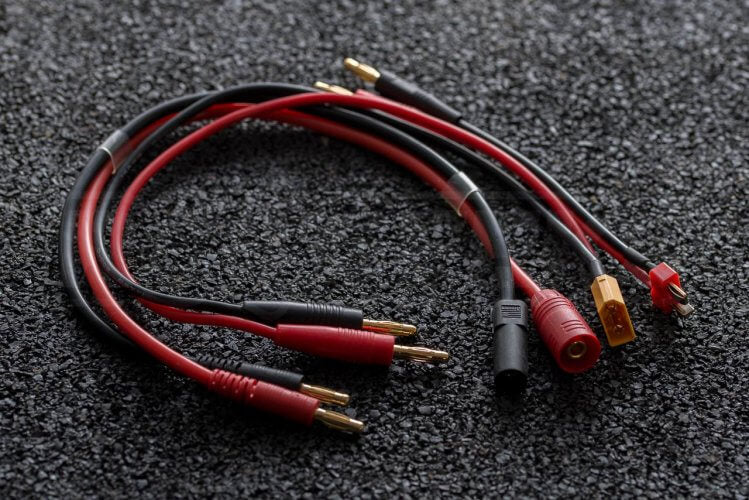
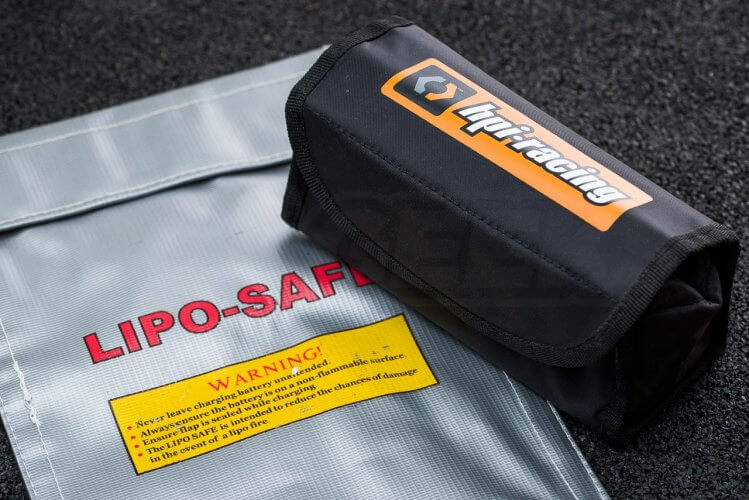 Avoid leaving a charging LiPo battery unattended and store them in LiPo safe bags when not in use. LiPo batteries should be stored at 3.8v per cell (down from 4.2v) to maximise their life, many chargers offer a 'storage' charge function to achieve this.
Avoid leaving a charging LiPo battery unattended and store them in LiPo safe bags when not in use. LiPo batteries should be stored at 3.8v per cell (down from 4.2v) to maximise their life, many chargers offer a 'storage' charge function to achieve this.  A tool like this Emax Digital Battery Capacity Checker is perfect for checking the charge and also the balance of cells within LiPo batteries.
A tool like this Emax Digital Battery Capacity Checker is perfect for checking the charge and also the balance of cells within LiPo batteries.
Before we begin – A disclaimer
It is worth stating that I am not a physicist; This blog is not intended to educate electronic theory at a high level, but rather to offer a non-technical look at the basics. As such we cannot take responsibility for any untoward effects caused as a result of misunderstanding this post. If you have any questions, please drop our friendly engineers a message and if you spot any errors in this blog, please leave your comments below and we will update it with corrections.Batteries
Batteries are bundles of chemical energy storage that allow us all to tear around carparks or dirt tracks for a few joyful minutes at at time. Lets get to know your current setup and how to decipher some of the jargon.
What battery does my car have?
The majority of batteries will have a sticker or some printed markings upon them, describing what type or technology they use. Relevant RC battery types/chemistries are listed below with typical uses.- Alkaline : Not rechargeable. Commonly found in AA batteries and used in transmitters, TV remotes etc.
- Ni-Cd : Nickel Cadmium. Rechargeable, comparatively environmentally unfriendly and suffer from memory effect.
- NiMH : Nickel Metal Hydride. Robustly rechargeable (can be topped off) and easy to maintain.
- LiPo : Lithium-ion polymer. Higher energy density, lighter weights, consistent powerful discharge, shorter lifespan (than NiMH) more volatile than other solutions and require intelligent chargers.
What does this battery label mean?
Batteries can have cryptic markings on them, lets take a look at a couple of examples to decipher what they mean.HPI Plazma NiMh battery
 This battery is well labelled and we have circled the core values to make it clear. It is a 7.2volt battery with 1800 mAh capacity, provided by NiMH (Nickel-Metal Hydride) chemistry. The capacity is also stated in Watt Hours (capacity divided by voltage) in this case 12.96Wh. These figures are typical for a bundled battery, 1800 mAh being the low-end of capacity for a stick pack of these dimensions. If you were looking to extend your run-time then swapping out to a 4700mAh battery with the same dimensions and connector would be the easiest step.
This battery is well labelled and we have circled the core values to make it clear. It is a 7.2volt battery with 1800 mAh capacity, provided by NiMH (Nickel-Metal Hydride) chemistry. The capacity is also stated in Watt Hours (capacity divided by voltage) in this case 12.96Wh. These figures are typical for a bundled battery, 1800 mAh being the low-end of capacity for a stick pack of these dimensions. If you were looking to extend your run-time then swapping out to a 4700mAh battery with the same dimensions and connector would be the easiest step.
Absima LiPo Battery
 Next we have a LiPo battery from Absima. Its 4200 name reflects its 4200mAh/31.1Wh rating that is less clearly labelled. The finer details are listed at the end of the label 7.4v (2 cell) LiPo technology with a 25C burst rate.
Next we have a LiPo battery from Absima. Its 4200 name reflects its 4200mAh/31.1Wh rating that is less clearly labelled. The finer details are listed at the end of the label 7.4v (2 cell) LiPo technology with a 25C burst rate.
Turnigy Nano-Tech LiPo battery
 Lastly this Turnigy Nano-Tech battery with its label offers a lot of information. The 35-70c labelling suggests it can be discharged continuously up to 35C and for short surges up to 70C, offering a little more detail to the 'high discharge Li-Po battery' marking below. On the right we can see that the 3 cell option has been marked, denoting that it features a 3-cell 11.1 volt setup. This high-end battery would be ideal for a high-load RC car, such as our brushless converted Traxxas Defender.
Lastly this Turnigy Nano-Tech battery with its label offers a lot of information. The 35-70c labelling suggests it can be discharged continuously up to 35C and for short surges up to 70C, offering a little more detail to the 'high discharge Li-Po battery' marking below. On the right we can see that the 3 cell option has been marked, denoting that it features a 3-cell 11.1 volt setup. This high-end battery would be ideal for a high-load RC car, such as our brushless converted Traxxas Defender.
What is this battery connector?
There are a variety of battery connectors on the market, each suited to a different application.Tamiya Connector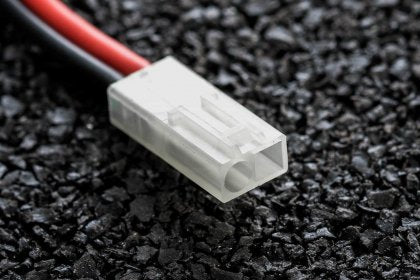
Our most common battery connector, found on the majority of NiMH batteries. These (sometimes translucent) white connectors feature a lever to unlock them before pulling them apart. They are keyed to aide installation but it is possible to force the connectors, so care must be taken to observe correct polarisation (connecting the positive to the positive and vice versa) such as identifying wire colours. Note: these are not designed for high current application such as big burst rate LiPo batteries and may overheat if used as such.
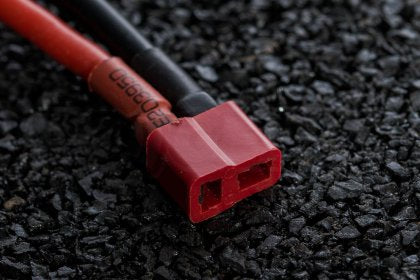 Deans/T Connector
Deans/T Connector
These short, chunky connectors are common for high current applications and are found on our HPI Plazma LiPo and Absima lipo batteries. They feature and the short plastic plug bodies, sprung flat tabs that maintain contact pressure against the metal prongs (which can be stiff to connect) and are keyed so will only connect one way round.XT60 Connector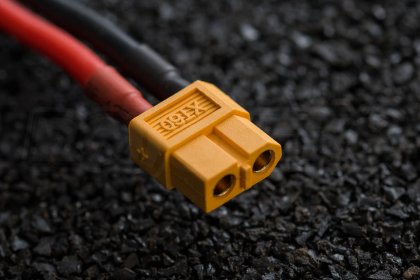
These high current connectors are popular with drone pilots are simple to use and are keyed to avoid incorrect connection.
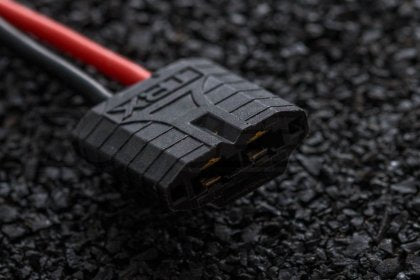 Traxxas Connectors
Traxxas Connectors
These rectangular proprietary high-current connectors are keyed to avoid incorrect connection and feature textured plugs to aid removal. Note that Traxxas now also employ a 'foolproof' iD connector with integral balance connector leads to simplify charging. These are intended for use with iD chargers and can be identified by their flattened octagonal connector.
 Molex Picoblade Connector
Molex Picoblade Connector
These tiny two pin connectors are found on batteries for micro drones and the HPI Q32 models. They are designed for use with low current chargers for example USB powered chargers. Again, care should be exercised when connecting these batteries as the small plugs can be forced together the wrong way round.
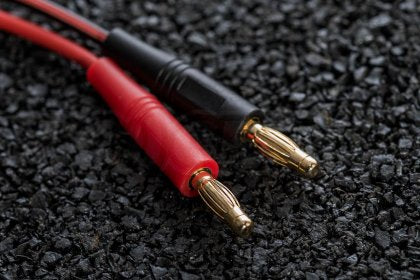 Bullet connectors
Bullet connectors
Often called banana plugs, these are commonly found on charger adapter leads rather than batteries. Available in a range of diameters the larger sizes can support high current, but attention must be paid when connecting them to ensure they are the correct way round.
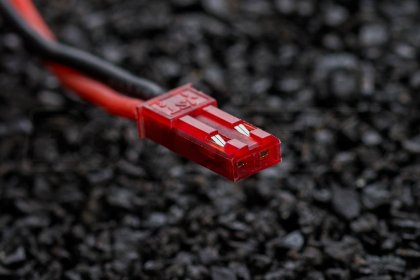 JST RCY Connector
JST RCY Connector
Often found inside of transmitters, these small, low current, thin-walled plugs are ideal for connecting rechargeable battery packs instead of using AA batteries.
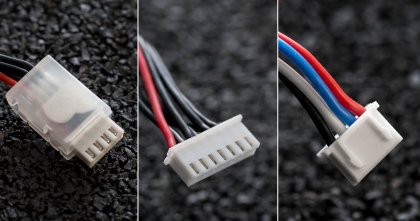 Balance Connector
Balance Connector
Found on multi-cell batteries, these (commonly white) multi-pin plugs provide a connector to each cell terminal inside of the battery for monitoring the voltage and manipulating each individually. This allows the charger to discharge a particular cell to balance the pack. There will be one wire for each cell plus a negative meaning a 3S battery balance plug will feature four pins. It is important to connect this plug to the charger when balance charging, something commonly overlooked by beginners. Note that some chargers can fill the battery using this low current connection, thus its inclusion in this list.
How do I choose the right Battery for my car?
Now that we have an understanding of some of the basics, we can select the right battery. On a simple level, this boils down to a few variables: cost, connector, compatibility and dimensions.Cost
If a battery has been included with the model, it is often selected by the manufacturer for a balance of performance, weight and production cost. Yet in ownership, many enthusiasts will want to buy batteries for their own financial needs. Several smaller capacity batteries are often cheaper, giving you the same combined runtime of a larger capacity battery whilst avoiding its much higher price and (often) additional weight.Connector Type
Check which connector type your ESC or current battery shipped with, use our guide above to assist in identifying it.ESC Compatibility
Further to this, check that your ESC is actually compatible with the new battery. Not just in the case of switching chemistries (from say NiMh to LiPo) but also when selecting a battery with more cells (eg a 4S LiPo from a standard 2S). This information can be found from the manufacturer or within the instruction booklet of your model.Physical Restrictions
The obvious limit to fitting a battery in your model are the dimensions of the battery tray. Many models offer a clamp-style setup that can be shimmed,to increase its effective capacity. Some users do away with the battery tray altogether and employ velcro straps to secure the battery to the chassis. Also worth mentioning is the weight of the battery as fitting a larger, heavier battery (than that specified by the manufacturer) will alter the performance and handling characteristics of the model, shifting its centre of gravity.Battery Chargers
Its all very well buying monstrous 5000mAh batteries to extend your runtime, but if you are still using your bundled charger you are going to have a wait a day before you can race again! An intelligent charger can make all the difference, getting you back out driving in a fraction of the time and also ensuring your batteries are properly cared for.Why is my charger so slow?
If you are on a limited budget, you are likely to be stuck with a trickle charger with a low output. For instance this lipo charger that charges via the balance port, or this more traditional 'tamiya' style twin-pin connector that comes bundled with many of our models. In the case of the later HPI charger with its 9.5v 330mA output, 'fully charging' a 7.2V 3300mAh battery would take 10 hours (thus this type of charger is often referred to as an 'overnight' one). This isn't ideal and as such we recommend the majority of customers (not just the enthusiasts) purchase a smart charger.
Which charger is best for me?
Smart chargers will typically come with a selection of battery leads, balance boards and other accessories enabling them to be used with many different types of battery. If you intend to use LiPo batteries they are a no-brainer. Typically the higher-end smart chargers will be able to balance, discharge and storage charge batteries, essential functions for both caring and prolonging the life of your batteries. This popular Overlander charger has a maximum fast charge output of 7A with support for 6cell LiPo and 8cell NiMH batteries. In comparison this could easily charge a 3300mAh battery in less than an hour. Its worth noting that regularly 'fast' charging batteries at high voltages will shorten their life.
This popular Overlander charger has a maximum fast charge output of 7A with support for 6cell LiPo and 8cell NiMH batteries. In comparison this could easily charge a 3300mAh battery in less than an hour. Its worth noting that regularly 'fast' charging batteries at high voltages will shorten their life.  Traxxas iD batteries are best charged with their EZ-Peak chargers such as the one above. This foolproof charger is designed to be used with the newer system with integrated balance cables, is compatible with both LiPo and NiMh cells and can safely charge at one button press.
Traxxas iD batteries are best charged with their EZ-Peak chargers such as the one above. This foolproof charger is designed to be used with the newer system with integrated balance cables, is compatible with both LiPo and NiMh cells and can safely charge at one button press.
I don't have the right lead
Additional charge cable adapters are available to 'future proof' a smart charger against future plug innovations. Note that such cables are designed for charging only and are generally not intended to be used as a battery adapter for powering your car.
How should I look after my batteries?
To get the best performance and life out of your batteries, you need to treat them right. Alkaline batteries commonly used to power transmitters are quite hardy, but we always recommend removing them from your controller if you do not intend to use the device for a long period. NiMh batteries are also robust but can be damaged by overcharging so investing in a quality monitoring charger is wise. There is no need to fully discharge and recharge them and they should be stored in a cool location LiPo batteries are more sensitive and thus precautions should be taken when handling and charging them. A high quality charger that utilises the balance lead and reduces its current when the peak cell voltage is reached is recommended. Whilst LiPo batteries can be charged at high rates, the safest rate is 1C, literally one times the capacity of the battery in amps. For example a 3000mAh battery should ideally be charged at 3Amps. Avoid leaving a charging LiPo battery unattended and store them in LiPo safe bags when not in use. LiPo batteries should be stored at 3.8v per cell (down from 4.2v) to maximise their life, many chargers offer a 'storage' charge function to achieve this.
Avoid leaving a charging LiPo battery unattended and store them in LiPo safe bags when not in use. LiPo batteries should be stored at 3.8v per cell (down from 4.2v) to maximise their life, many chargers offer a 'storage' charge function to achieve this.  A tool like this Emax Digital Battery Capacity Checker is perfect for checking the charge and also the balance of cells within LiPo batteries.
A tool like this Emax Digital Battery Capacity Checker is perfect for checking the charge and also the balance of cells within LiPo batteries.






